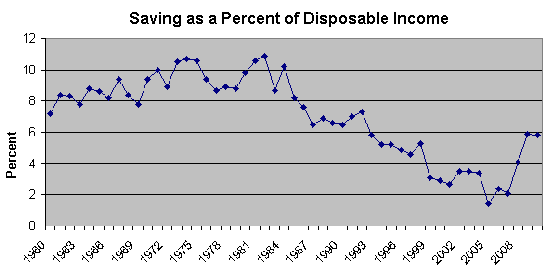September 30, 2011
The NYT had an article about the prospects of persistently slower growth in Europe and the U.S. as a result of the current downturn. It told readers that:
“Now, just as the United States economy is held back by households whose mortgages are still underwater and who won’t begin to spend again until they have run down their debts, Europe can’t begin to grow again until its countries learn to live within their means.”
Actually, the United States economy is not being held back by a lack of consumer spending. The ratio of spending to income is still considerably higher than the pre-bubble average as reflected by the lower than normal saving rate. The problem is that the bubble had generated excessive consumption demand, which is not being replaced by any other source of demand.
 Source: Bureau of Economic Analysis.
Source: Bureau of Economic Analysis.
The piece also inaccurately asserts that:
“in Europe it was mainly governments that piled on the debt, facilitated by banks that lent them money by buying up sovereign bonds.”
Actually, Ireland and Spain, two of the most troubled countries, ran budget surpluses in the years preceding the downturn. They ran into trouble because they both had large housing bubbles which burst and left their economies in crisis.
It would also have been useful if the chart showing debt to GDP ratios included Japan. The IMF shows Japan’s debt to GDP ratio at the end of this year as being 229 percent. Excluding Greece, this is almost twice as large as any debt burden shown in the chart. Japan can currently pay just over 1.0 percent interest on its long-term debt. If Japan had been included, it would have suggested that the debt levels may not be as troubling as the piece implies.







Comments